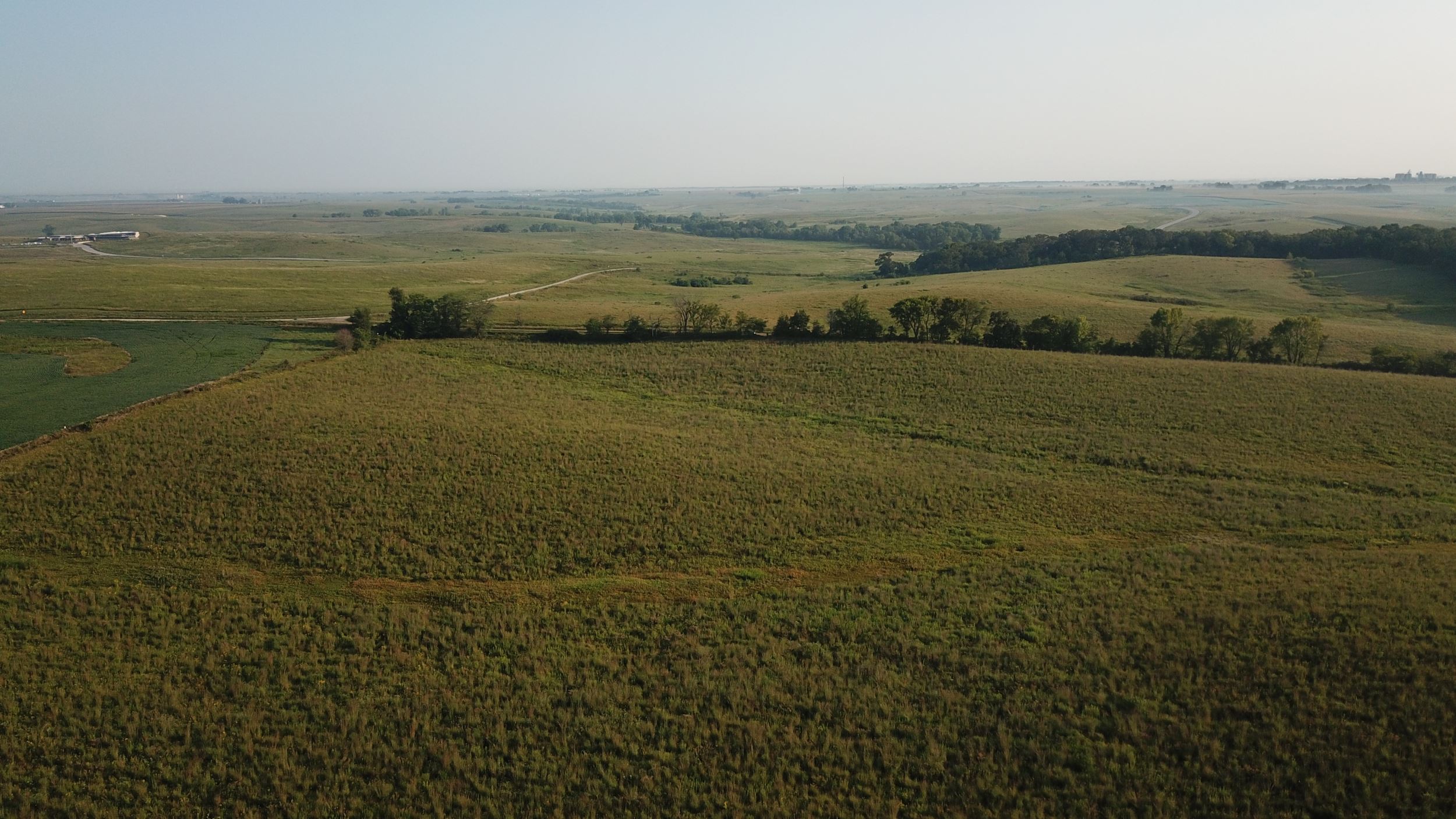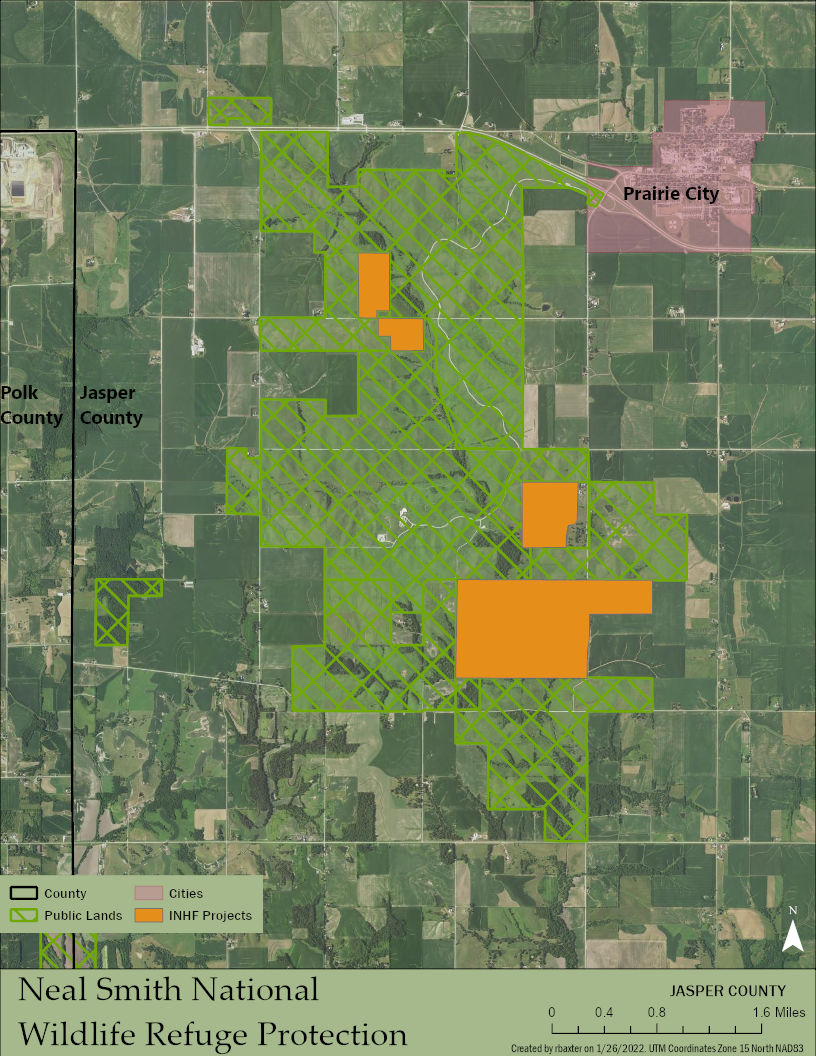A Wild Idea
By Katy Heggen on April 21, 2022 in Blog
.JPG)
Photo by Ross Baxter/INHF
Half an hour east of Des Moines, the Neal Smith National Wildlife Refuge offers a look into Iowa's prairie past - and here, present - complete with roaming bison and elk, native wildflowers, grasses and sedges. But it hasn’t always been this way.
Roots
Like the majority of Iowa’s landscape, the native habitat at the Refuge, which includes tallgrass prairie, oak savanna and sedge meadow, gave way to subsistence farming during the mid 1800s, and later, commodity farming. Iowa Power and Light Company (now known as MidAmerican Energy) purchased much of this farmland in the 1970s with the intention of building a nuclear power plant. When that plan was scrapped in the late 1980s, then-retired Representative Smith saw an opportunity.
Spurred by an effort led by Rep. Neal Smith, Congress authorized the U.S. Fish and Wildlife Service (USFWS) to acquire 8,600 acres of land from willing landowners in 1990 for the purpose of establishing a nature preserve. The first 3,600 acres were purchased from the Iowa Power and Light Company in 1991. Dedicated first as the Walnut Creek National Wildlife Refuge, the refuge was later renamed in honor of Smith in 1998.
New growth
In the 31 years since its founding, thousands of additional acres have been purchased, restored and permanently protected as part of the Refuge. At over 6,000 acres, it is now one of the largest tallgrass prairie restorations in the world and home to a diverse range of species, a visitor center and many educational, recreational and research activities.
In recent years, Iowa Natural Heritage Foundation (INHF) has had the opportunity to partner with local landowners, USFWS and the Friends of Neal Smith National Wildlife Refuge to help purchase and permanently protect four additions to the Refuge totaling 816 acres. Once fully transferred, these additions will fill in several key inholdings within the refuge.

“With INHF’s direct support, over 800 acres in the last decade have been restored back into tall grass prairie, an ecosystem that was almost entirely wiped out from the Iowa landscape during European settlement and beyond,” said Scott Gilje, project leader at the Refuge. “The lands provide habitat to many of Iowa’s resident and non-resident species and provide the visiting public with many outdoor activities – wildlife viewing, photography, hunting, and exploring the treasures of Iowa. I look forward to working with INHF on our next projects and moving the needle for conservation in a positive direction.”
At the time of purchase, all four additions were overwhelmingly agricultural in nature. The first, a 565-acre addition on the south end of the Refuge, was purchased from the Rothinghouse Trust in 2008. However, at the time of purchase, there was no clear way to fund a transfer to USFWS. The Friends of Neal Smith Wildlife Refuge, an active volunteer group that is a vital part of the Refuge, stepped forward to provide over half the financial capital INHF needed to hold the property long-term while federal funding opportunities were identified.
“The significance of these additions to the Refuge cannot be emphasized enough. These parcels create more continuous, connected habitat areas that will benefit the water quality of the area and increase wildlife habitat,” said Friends of Neal Smith Wildlife Refuge President Joan Van Gorp. “The Friends are proud to have been instrumental, with the help of INHF, in increasing the size of the Refuge and protecting these areas. I look forward to the day when a visitor driving through the Refuge will have an unobstructed view as far as they can see of the tallgrass prairie’s unique beauty.”
In addition to restoring the property’s former crop acres to prairie, USFWS staff will enhance the existing habitat along Walnut Creek, which cuts through the middle of the property. The first 100 acres transferred in 2016 – the first new addition to the Refuge in over a decade. Two-hundred-thirty-one additional acres transferred to the Refuge in 2017 and have already been seeded to prairie, along with another transfer of 82 acres in November of 2020. The remaining 152 acres are expected to transfer within the next 18 months.
The second addition, which includes 49 acres in the middle of the preserve, adjacent to the bison and elk enclosures, was purchased from the Van Ryswyk family in 2015. An additional 74 acres was purchased from the same family four years later in 2019. The first 49 acres transferred in 2020 and have already been seeded to prairie. The second 74 acres are slated to go to the USFWS sometime in the next two years.
The fourth addition was purchased in-between the former additions in 2017 as part of a land trade with the Curry family, who wanted to maintain their agricultural acreage but were willing to trade this parcel in the eastern part of the Refuge for land further out. It includes 127 acres that will be restored to prairie, and is slated to become part of the Refuge within the next year. This parcel was particularly important as it includes a scenic area along the primary road through the middle of the Refuge.
“In addition to expanding the acreage of the Refuge, all four of these additions fill in critical inholdings and help create more contiguous habitat, preserve open space and protect the viewshed (the view of an area from a specific vantage point),” said Land Projects Director Ross Baxter. “This is especially important here, not only for the Refuge’s wildlife, but also for the thousands of visitors who come each year to experience this special place.”
Horizon lines
At its essence, the Neal Smith National Wildlife Refuge is an ongoing experiment in prairie protection and restoration. Over the years, that experiment has produced some pretty impressive results. The Refuge is now home to well over one-hundred native plant species, more than 200 bird species and dozens of native pollinators, as well as other insects, mammals, reptiles and amphibians.
Equally as important, it continues to be a source of unfettered joy, awe and inspiration for those who come to gaze upon the wind-whipped landscape and its many inhabitants, and serves as an example of what nature and those who love it are capable of, if only given the chance.
